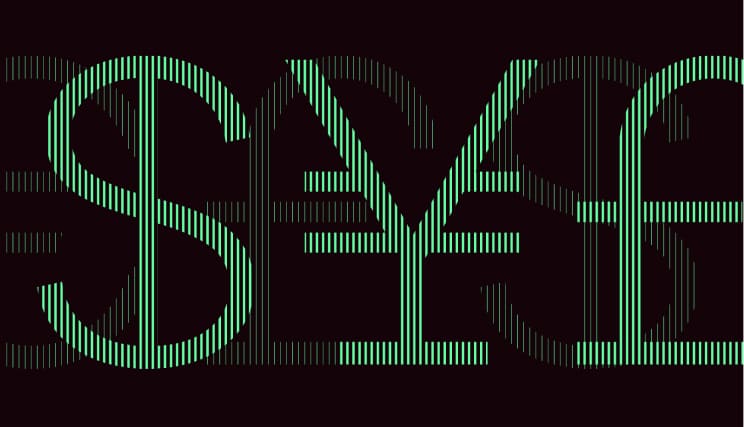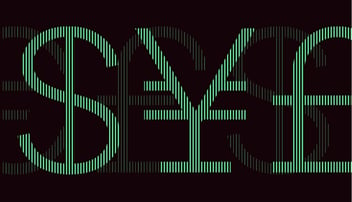Gain an overview of the latest developments on the currency market and anticipate fluctuation risks.
Unknown and known unknowns
As we enter the autumn, there are some known unknowns: the US presidential election, rate cuts by central banks and the direction of the dollar. We know that the US presidential election will in reality have few long-term effects on the currency market. Despite market speculation of a 50 basis point rate cut by the US Federal Reserve (Fed) in September, we forecast a cut of just 25 basis points. Lastly, even though the dollar index has weakened slightly over the past fortnight, we are still in a strong dollar world. In contrast, there are also some unknown unknowns: the trajectory of Chinese growth, abnormally weak liquidity in all market segments, including the currency market, and geopolitical developments in the Middle East.
EUR/USD
High: 1.1201 Low: 1.0776 Change: +2.48%
Many credit the improvement in the eurozone’s outlook with the appreciation of the single currency. Unfortunately, there has been no real improvement in the economic environment. In reality, the drop in US bond yields linked to receding inflation and monetary loosening by the Fed is primarily responsible for the euro’s appreciation. Investors, especially hedge funds, are selling dollars to invest their capital in other currencies, boosting the euro. Is this trend sustainable? Probably not.
EUR/GBP
High: 0.8618 Low: 0.8410 Change: -0.25%
For a long time, this pair delivered few surprises, moving within a narrow range around 0.86. But things have changed and the euro has entered a significant downward trend towards 0.84 since the summer. We think the EUR/GBP pair could stabilise in the months ahead at around 0.83-0.84, which appears to be its new cruising zone.
GBP/USD
High: 1.3282 Low: 1.2672 Change: +2.63%
There has been a marked change in sentiment towards sterling in recent weeks. The market is clearly bullish, especially against the US dollar. We think this movement may be lasting and even continue into part of next year.
EUR/CNH
High: 7.9634 Low: 7.7604 Change: +0.12%
We had already warned you last year of those predicting a devaluation of the CNH to revive exports and growth in a context of stagnant credit. This did not materialise, and it will not do so in 2025 either. For the third time in 27 years, China is set to miss its 5% growth target for 2024. But the government clearly wants to avoid the same mistakes as in 2015 and will not opt to boost its competitiveness through a currency devaluation. We think it is in Beijing’s interest to have a fairly stable currency, particularly against the dollar but also against the euro.
EUR/CHF
High: 0.9588 Low: 0.9285 Change: -1.46%
The CHF’s recent upward trend is clearly not sustainable, especially if the SNB intervenes. We expect the EUR/CHF to strengthen in the months ahead. Beware of political and geopolitical risk that could trigger pullbacks.
EUR/CAD
High: 1.5196 Low: 1.4935 Change: -0.27%
Short positions in the CAD have decreased slightly for the second week running. But the market is still predominantly short. From a monetary policy perspective, we foresee one rate cut by the Bank of Canada (BoC) in September and another in October, each of 25 basis points.
EUR/AUD
High: 1.7184 Low: 1.6308 Change: -1.55%
This is undoubtedly the pair on which visibility is weakest this year. The complicated macroeconomic backdrop in Australia does not help, with a mix of signals pointing to a risk of recession and others highlighting inflationary pressures. We doubt the Reserve Bank of Australia (RBA) will raise its rates again. It could have done so in July, but decided not to. That said, the rate-cutting cycle may be slower in Australia than in other developed economies. In theory, this should be a long-term support factor for the Australian dollar.
EUR/JPY
High: 167.95 Low: 154.41 Change: -2.60%
Last year, when we set out our annual forecasts, we told you the pair would swing. This has indeed been the case. Up until the end of July 2024, the yen plunged against its principal counterparties. Measured in purchasing power parity terms, the yen even reached its lowest level since the late 1970s. But nothing lasts. The Bank of Japan (BoJ) raised its policy rate to 0.25% in July. The next moment, the market went into panic mode and liquidated short positions in the yen, as we mentioned in the foreword. Many hedge funds took a battering. For the first time since 2021, they have taken long positions in the Japanese currency. Further rate hikes expected in the fourth quarter of 2024 and next year should allow the Japanese currency to continue its upward trend.
EUR/HUF
High: 399.19 Low: 392.04 Change: -0.74%
For approximately the past six months, the EUR/HUF has moved within a narrow range of 20 pips between 380 and 400. This price zone satisfies the Hungarian authorities, who are now less interventionist in the markets. We doubt that Hungarian monetary policy will be a truly differentiating factor for the pair in the short term, as most rate cuts in Hungary are now behind us
USD/HUF
High: 367.97 Low: 351.12 Change: -3.01%
The dollar index has fallen slightly over the past fortnight, mainly because of expectations of rate cuts by the US Federal Reserve in September. But we think the underlying trend remains upwards, especially against the HUF.
Economic Calendar
| DATE | CURRENCY | EVENT |
| 06/09 | USD |
US employment and unemployment report for August |
| 10/09 | USD | Presidential debate between Donald Trump and Kamala Harris |
| 11/09 | USD |
US inflation in August |
| 12/09 | EUR |
ECB monetary policy meeting |
| 18/09 | USD |
Fed monetary policy meeting |
| 19/09 | GBP |
Bank of England monetary policy meeting |
| 20/09 | EUR |
Deadline for France to submit a fiscal recovery plan to the European Commission |
| 24/09 | AUD |
Reserve Bank of Australia monetary policy meeting |
| 26/09 | CHF |
Swiss National Bank monetary policy meeting |
| End September (TBC) | JPY |
JPY Election of the new head of the LDP party who will become Japan’s Prime Minister |
Topics




